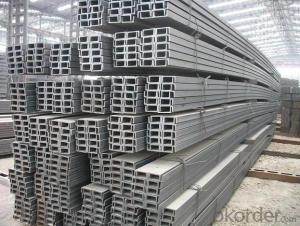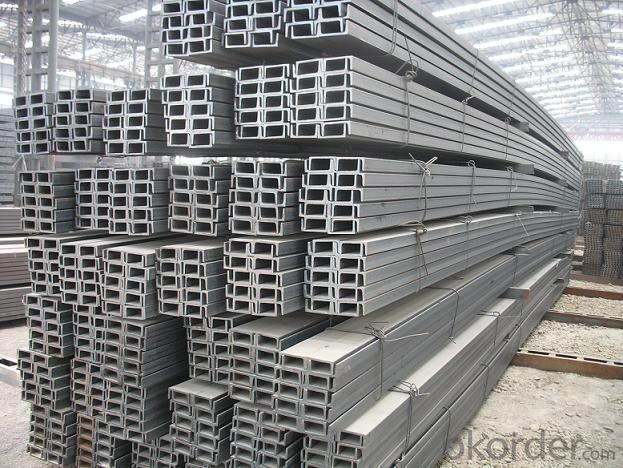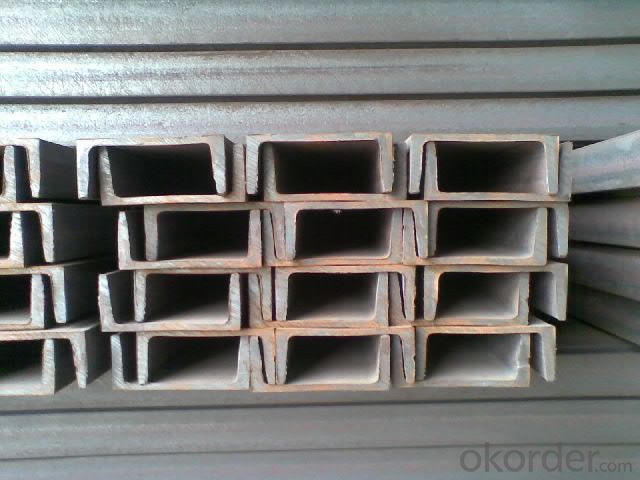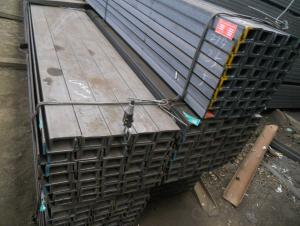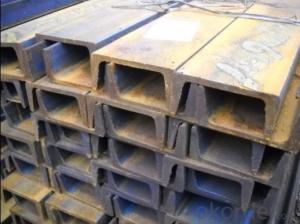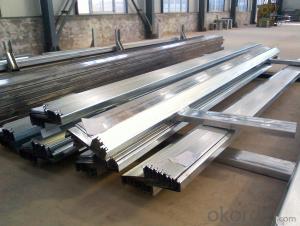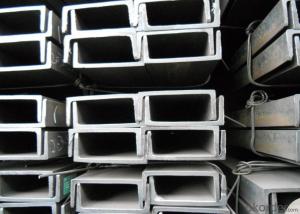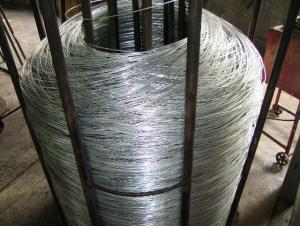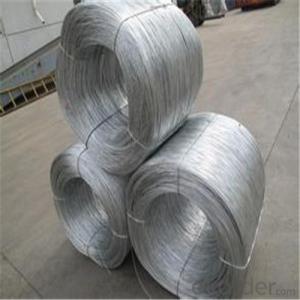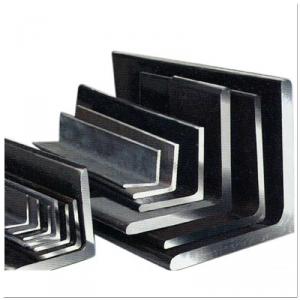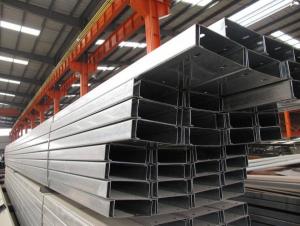Steel U Channel Steel Bar Hot Dip Galvanized
- Loading Port:
- Tianjin
- Payment Terms:
- TT or LC
- Min Order Qty:
- 24 m
- Supply Capability:
- 35000 m/month
OKorder Service Pledge
OKorder Financial Service
You Might Also Like
Product Description:
OKorder is offering Steel U Channel Steel Bar Hot Dip Galvanized at great prices with worldwide shipping. Our supplier is a world-class manufacturer of steel, with our products utilized the world over. OKorder annually supplies products to European, North American and Asian markets. We provide quotations within 24 hours of receiving an inquiry and guarantee competitive prices.
Product Applications:
Steel U Channel Steel Bar Hot Dip Galvanized are ideal for structural applications and are widely used in the construction of buildings and bridges, and the manufacturing, petrochemical, and transportation industries.
Product Advantages:
OKorder's Steel U Channel Steel Bar Hot Dip Galvanized are durable, strong, and resist corrosion.
Main Product Features:
· Premium quality
· Prompt delivery & seaworthy packing (30 days after receiving deposit)
· Corrosion resistance
· Can be recycled and reused
· Mill test certification
· Professional Service
· Competitive pricing
Product Specifications:
1.Good quality and competitive price.
2.Material: Q235, Q345, SS400, ASTM A36, S235JR, SS540
3. Length: 6m, 9m, 12m
4. Standard: ASTM JIS GB DIN
5. Application: construction, machine, vehicle, engineering, etc
6. Port of Loading: Tianjin
7. Delivery Time: 25 days after confirming your order
8. Packing: in bundle
Advantage:
(1). Design according to customers’ requirements
(2). Manufacture under complete quality control system---ISO9001:2008
(3). Installation with instruction of experienced engineers
(4). Easy to assemble and dismantle
(5). Eco-friendly material: can be used for several times and can be recycled
(6). Shorter construction period, longer using time
(7). High strength and stiffness, high weight bearing.
| JIS U CHANNEL | |||
| Standard Sectional | Web thickness (mm) | Flange thickness(mm) | Weight (kg/m) |
| Dimension (mm) | |||
| 50*25 | 3.00~5.00 | 6 | 2.37~3.46 |
| 75*40 | 3.8 | 7 | 5.3 |
| 75*40 | 4 | 7 | 5.6 |
| 75*40 | 4.5 | 7 | 5.85 |
| 75*40 | 5 | 7 | 6.92 |
| 100*50 | 3.8 | 6 | 7.3 |
| 100*50 | 4.2 | 6 | 8.03 |
| 100*50 | 4.5 | 7.5 | 8.97 |
| 100*50 | 5 | 7.5 | 9.36 |
| 125*65 | 5.2 | 6.8 | 11.66 |
| 125*65 | 5.3 | 6.8 | 12.17 |
| 125*65 | 5.5 | 8 | 12.91 |
| 125*65 | 6 | 8 | 13.4 |
| 150*75 | 5.5 | 7.3 | 14.66 |
| 150*75 | 5.7 | 10 | 16.71 |
| 150*75 | 6 | 10 | 17.9 |
| 150*75 | 6.5 | 10 | 18.6 |
| 200*80 | 7.5 | 11 | 24.6 |
| 250*90 | 9 | 13 | 34.6 |
| 300*90 | 9 | 13 | 38.1 |
FAQ:
Q1: Why buy Materials & Equipment from OKorder.com?
A1: All products offered byOKorder.com are carefully selected from China's most reliable manufacturing enterprises. Through its ISO certifications, OKorder.com adheres to the highest standards and a commitment to supply chain safety and customer satisfaction.
Q2: How do we guarantee the quality of our products?
A2: We have established an advanced quality management system which conducts strict quality tests at every step, from raw materials to the final product. At the same time, we provide extensive follow-up service assurances as required.
Q3: How soon can we receive the product after purchase?
A3: Within three days of placing an order, we will begin production. The specific shipping date is dependent upon international and government factors, but is typically 7 to 10 workdays.
Q4: What makes stainless steel stainless?
A4: Stainless steel must contain at least 10.5 % chromium. It is this element that reacts with the oxygen in the air to form a complex chrome-oxide surface layer that is invisible but strong enough to prevent further oxygen from "staining" (rusting) the surface. Higher levels of chromium and the addition of other alloying elements such as nickel and molybdenum enhance this surface layer and improve the corrosion resistance of the stainless material.
Q5: Can stainless steel rust?
A5: Stainless does not "rust" as you think of regular steel rusting with a red oxide on the surface that flakes off. If you see red rust it is probably due to some iron particles that have contaminated the surface of the stainless steel and it is these iron particles that are rusting. Look at the source of the rusting and see if you can remove it from the surface.
Images:
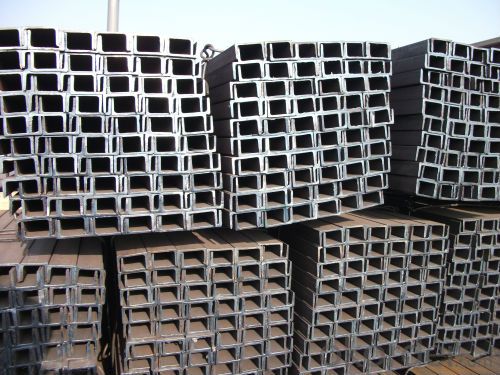
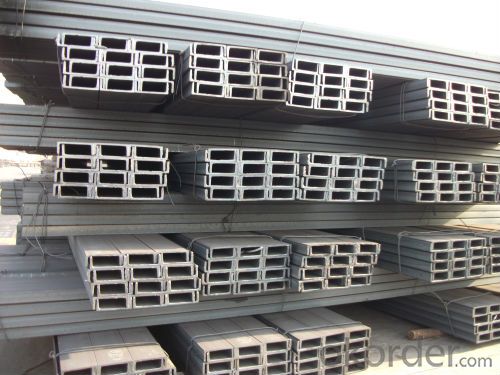
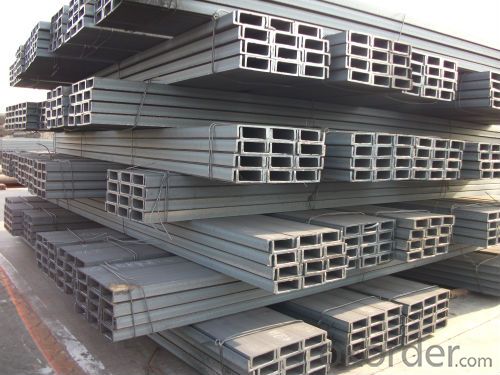
- Q: How do steel channels contribute to the overall longevity of a structure?
- Steel channels contribute to the overall longevity of a structure in several ways. Firstly, steel channels are known for their strength and durability. They can withstand heavy loads and resist deformation, ensuring the structural integrity of the building over time. This strength is particularly important in areas prone to earthquakes, strong winds, or heavy snow loads. Additionally, steel channels provide a high degree of corrosion resistance. Steel is inherently resistant to rust and deterioration, especially when properly coated with protective finishes. This resistance to corrosion ensures that the structure remains stable and secure for an extended period, even in harsh environments or coastal areas where saltwater exposure is a concern. Moreover, steel channels are highly versatile and can be easily customized and fabricated to meet specific design requirements. This adaptability allows architects and engineers to create complex and innovative structures that are both aesthetically pleasing and structurally sound. Steel channels can be integrated into various building systems, such as framing, roofing, and cladding, providing a seamless and efficient construction process. Furthermore, steel channels have a long lifespan compared to other building materials. Unlike wood or concrete, steel does not rot, warp, or crack over time. This longevity reduces the need for frequent repairs and replacements, saving both time and money in the long run. Additionally, steel is a sustainable and recyclable material, contributing to the overall environmental friendliness of the structure. In conclusion, steel channels contribute significantly to the overall longevity of a structure by providing strength, durability, corrosion resistance, versatility, and a long lifespan. Their ability to withstand various loads and environmental conditions ensures the structural integrity of the building, while their customization options and recyclability make them an excellent choice for sustainable construction practices.
- Q: Channel 10 is calculated, if the price per metre is calculated
- When choosing, we can know the gap between the channel and the national standard through weighing. The weight difference is different, the price also has the difference. If calculated, the greater the negative difference, the lower the offer. For example, the current market in Guangxi minus 10% of the 10 steel, according to the theory, the offer is probably 5000 yuan / ton, that is, 50 yuan / meter.
- Q: What do you mean by channel 8 A?
- It is usually said the channel No. 8 No. 8 channel, its height is 80MM, width is 43MM, no A and B channel No. 8 points, only a model, if the other channel with A and B, C, but its width is not the same, but always the same.
- Q: Are there any specific safety considerations when working with steel channels?
- Working with steel channels requires specific safety measures. These include: 1. Personal protective equipment (PPE): It is crucial to wear the appropriate PPE when handling steel channels. Safety goggles, gloves, steel-toed boots, and a hard hat should be worn to protect against potential hazards like flying debris, sharp edges, and falling objects. 2. Proper handling and lifting: Steel channels can be heavy and difficult to maneuver, so it is important to use correct lifting techniques and equipment to prevent strain or injury. This may involve using lifting straps, slings, or cranes to safely lift and transport the channels. 3. Careful handling of sharp edges and corners: Steel channels often have sharp edges and corners that can cause cuts or punctures. It is important to handle them with caution and use appropriate tools, such as gloves, to avoid direct contact with these hazardous areas. 4. Ensuring structural stability: When working with steel channels in construction or fabrication, it is vital to ensure the stability of the structure. This includes securely fastening the channels, using suitable support systems, and adhering to engineering specifications to prevent accidents or collapses. 5. Fire prevention: Steel channels are highly conductive and can rapidly transfer heat, making them a potential fire hazard. Precautions should be taken to avoid sparks or open flames from coming into contact with the channels, especially in environments where flammable materials are present. 6. Preventing slips, trips, and falls: Working with steel channels often involves working at heights or on elevated surfaces. To prevent slips, trips, and falls, it is important to maintain a clean work area, free of obstructions, and utilize proper ladder or scaffolding systems. Fall protection equipment should also be used when necessary. By following these safety precautions and implementing best practices, the risk of accidents and injuries can be significantly reduced when working with steel channels.
- Q: Are steel channels suitable for the oil and gas industry?
- Yes, steel channels are suitable for the oil and gas industry. They offer high strength, durability, and corrosion resistance, making them ideal for various applications such as structural support, piping systems, and equipment fabrication in the oil and gas sector.
- Q: Can steel channels be used in the marine industry?
- Steel channels, also referred to as steel C-channels or structural channels, are applicable in the marine industry. They possess versatility and are extensively utilized in various sectors, including marine applications. These channels are commonly employed for structural support, framing, and reinforcement in marine vessels, offshore platforms, docks, and other related structures. The utilization of steel channels in the marine industry brings forth several advantages. Firstly, steel is a robust and long-lasting material capable of enduring the harsh marine environment, encompassing saltwater exposure, waves, and extreme weather conditions. This quality makes steel channels highly suitable for imparting structural integrity and stability to marine structures. Additionally, steel channels can be readily fabricated and tailored to meet specific design requirements. They can be cut, welded, and formed into diverse shapes and sizes, thus allowing for flexibility in construction and design. This adaptability is essential in the marine industry, where structures must be customized to suit particular applications and specifications. Moreover, steel channels exhibit exceptional load-bearing capacity, rendering them suitable for supporting heavy equipment and loads in the marine industry. They can function as beams, columns, or bracing elements, distributing weight and stresses uniformly, thereby ensuring the safety and stability of marine structures. Furthermore, when properly coated or protected, steel channels display commendable corrosion resistance. This feature is particularly significant in the marine industry where structures are consistently exposed to saltwater, which can expedite corrosion. By employing appropriate coatings or galvanization methods, steel channels can withstand the corrosive impact of seawater, thus prolonging their lifespan and reducing maintenance costs. In conclusion, steel channels are a viable choice for the marine industry due to their strength, durability, versatility, and corrosion resistance. They are widely employed for supporting, framing, and reinforcing marine structures, thereby contributing to the overall safety and longevity of such structures.
- Q: Can steel channels be used for curtain wall framing?
- Yes, steel channels can be used for curtain wall framing. Steel channels are often used in curtain wall systems for their strength and durability. They provide structural support and are able to withstand the load and pressure from the curtain wall system. Steel channels are versatile and can be designed to fit the specific requirements and dimensions of the curtain wall. Additionally, steel channels can be easily fabricated and installed, making them a popular choice for curtain wall framing.
- Q: What is the weight of steel channels?
- The weight of steel channels can vary depending on the specific dimensions and thickness of the channel. However, as a general guideline, the weight of steel channels can be calculated using the formula: Weight (kg/m) = Width (mm) x Height (mm) x Thickness (mm) x 0.00785 This formula assumes that the steel channel is made of mild steel. Additionally, it is important to note that the weight of steel channels is typically measured in kilograms per meter (kg/m).
- Q: How do steel channels contribute to the stability of a structure during tornadoes?
- Several factors contribute to the stability of a structure during tornadoes, and steel channels are one of them. One way in which steel channels contribute is their composition of high-strength steel, which enables them to resist both compression and tension forces. This strength allows the channels to endure the powerful winds and forces generated by tornadoes. Furthermore, steel channels are commonly utilized as structural members in building framing. They are typically positioned vertically or horizontally between the main columns and beams, creating a interconnected support system. This system helps distribute the load and forces generated by tornadoes throughout the structure, preventing concentrated stress points and potential collapses. Moreover, steel channels can be strategically placed in load-bearing walls or used as bracing elements to enhance a building's structural integrity. These channels act as reinforcements, providing additional support and stiffness to the walls, which is particularly important during tornadoes when the structure is subjected to intense wind pressures. This reinforcement helps prevent the walls from buckling or collapsing under extreme forces. Additionally, steel channels are often integrated into the construction of storm shelters or safe rooms, which are specifically designed to protect occupants during tornadoes. These channels are incorporated into the walls, ceiling, and floor of these shelters, creating a sturdy and secure enclosure capable of withstanding the destructive forces of a tornado. In conclusion, steel channels play a crucial role in enhancing the stability of structures during tornadoes. Their high strength, ability to distribute forces, and reinforcement capabilities make them an essential component for ensuring the safety and integrity of buildings in areas prone to tornadoes.
- Q: Can steel channels be used for noise reduction purposes?
- Yes, steel channels can be used for noise reduction purposes. Steel channels, also known as acoustic metal channels, are often used as part of a soundproofing system in buildings and structures. They are designed to minimize the transmission of sound by absorbing and dampening noise vibrations. Steel channels are typically made from high-quality steel and have specific dimensions and shapes that help improve their acoustic properties. They are often installed between walls, floors, or ceilings to create a barrier that prevents sound from passing through. The effectiveness of steel channels in reducing noise depends on various factors, such as the thickness and material of the channel, the type and frequency of the noise, and the overall soundproofing system in place. When properly installed and combined with other soundproofing materials like insulation, acoustic panels, or mass-loaded vinyl, steel channels can significantly reduce the amount of noise that enters or leaves a space. It is important to note that while steel channels can be effective in reducing noise, they may not completely eliminate all sounds. Some low-frequency or high-intensity noises may still penetrate through the soundproofing system. Therefore, it is crucial to consult with professionals or acoustic engineers to determine the most suitable soundproofing solutions based on specific requirements and noise levels.
Send your message to us
Steel U Channel Steel Bar Hot Dip Galvanized
- Loading Port:
- Tianjin
- Payment Terms:
- TT or LC
- Min Order Qty:
- 24 m
- Supply Capability:
- 35000 m/month
OKorder Service Pledge
OKorder Financial Service
Similar products
Hot products
Hot Searches
Related keywords
